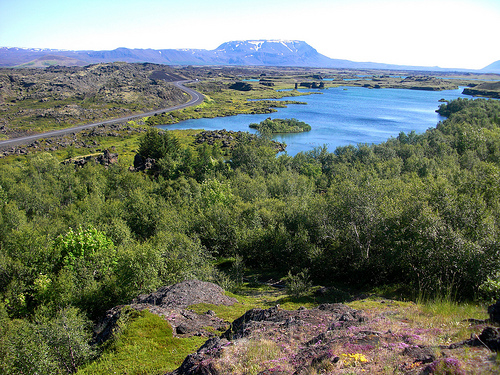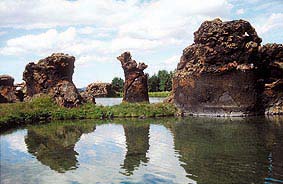|
LAKE MYVATN
Bubbling
mud flats, lunaresque volcanic craters, newborn lava fields,
and grassy shoals teeming with waterfowl! These are among
the sights of
the striking Lake Myvatn region, one of the most geologically active
and stunningly beautiful areas in Iceland. Lake Myvatn and
the
surrounding are one of Iceland’s most popular tourist
destinations for many reasons. It´s renowned for its awesome
natural beauty, with volcanic eruptions having played a crucial role in
the formation of the landscape since ancient times.
 Nine eruptions took place there during the period 1975-1984 and the continental drift was measured 4,8 m. This show of nature's immense power, gave the scientist the first real opportunity to study the plate tectonics, on dry land. In 1974, the lake was declared a national conservation area, and since then it has become one of the most popular tourist destinations in the country. Its name means “Midge Lake,” after the hordes of gnats that breed in the shallow waters (so bring bug net), but the pesky insects – perfect food for fish – support one of the best trout and salmon fishing in Iceland. There are also more species of duck there than anywhere in Europe, 15 in all. The most compact habitation of harlequin ducks in the world, is at the upper reaches of "Laxa" river, and the barrow’s golden eye duck breeds in no other place in Europe. River trout is caught in great abundance in lake Myvatn, but Brown trout can be caught there also. A special variant of the Arctic Char can be found in the cold spring areas in the lake. In the upper part of river Laxa, Brown trout is the main catch, but a little Arctic Char is sometimes caught there, too. Salmon migrates from the sea to the lower parts of the river. Farmers lay nets in Myvatn lake in the summer and winter, and they fish using a hook and line in late winter. You can buy a license to fly-fish. Information center for tourists is in Reykjahlid (Hraunvegur 6, 660 Myvatn).  Lake Myvatn is the country's fourth largest spring water lake, covering 36.5 square kilometers, or approximately 14 square miles. About 35 cubic meters of water, flows each second from a myriad of cold and warm springs, at the banks of the lake. The water is rich in minerals, and is the main reasons for the fertility of the lake. With the aid of sunlight, a great amount of algae grows in the lake. The algae provides sustenance for midge larvae and crabs, which are food for birds and fishes. Black fly larvae sift substances from the water and constitute the river Laxá most important food. The female flies, suck blood from livestock and people, and thus gain nourishment for breeding. At the bottom of the lake, an abundance of midge larvae thrives, transforming into pupae and growing into midges during the summer, particularly at the beginning of June and August. The male flies gather in swarms at the lake's edge and over knolls and hills on still days. These midges are called chironomidae (rykmy) and are plenty but harmless.
|